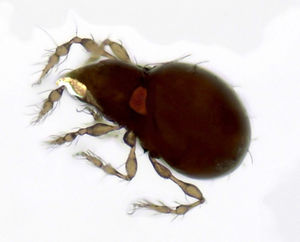Oribatida: Difference between revisions
| Line 46: | Line 46: | ||
Order: Oribatida | Order: Oribatida | ||
== Biology == | == Biology == | ||
Revision as of 14:36, 10 March 2023
Oribatida (previously called Cryptostigmata), also known as oribatid mites, moss mites, beetle mites, or oribatid mites, are an order of mites, and the oldest mite group, found in fossils up to 400 million years ago.

Abundance and Diversity
Oribatid mites are distributed worldwide and are commonly found at a density of 50,000 to 500,000 individuals per square meter in soils. Oribatid mites are known to predominate over other groups of mites and mesofauna in most soils. They live in all terrestrial ecosystems, including the arctic and the tropics. Coniferous forests typically have the highest numbers of oribatid mites, followed by deciduous hardwood forests, grasslands, deserts, then tundra. Their numbers are reduced in highly developed or agriculturally developed areas. Oribatid mites are a highly diverse order of mites, with varying numbers of species being found in different areas based on habitat, however, there are well over 150 different species reported in some areas. In addition to being one of the most abundant soil species, oribatid mites are an arboreal species as well, which was not discovered until recently (~20 years ago).
Scientific Classification
| Kingdom: | Animalia |
|---|---|
| Phylum: | Arthropoda |
| Class: | Arachnida |
| Subclass: | Acari |
| Superorder: | Acariformes |
| Order: | Oribatida |
Kingdom: Animalia
Phylum: Arthropoda
Subphylum: Chelicerata
Class: Arachnida
Subclass: Acari
Superorder: Acariformes
Order: Oribatida
Biology
Orbitida is the largest order of mites containing more than 12,000 identified species and an estimated 60,000-120,000 additional species. Oribatida is distributed worldwide and is commonly found at a density of 50,000 to 500,000 individuals per square meter in soils. Orbitida is found worldwide, with their preferred ecosystem generally on the moist forest floor surrounded by organic material and moss. Oribatid mites have created tens of thousands of niches due to their adaptations to a specific climate. Their numbers are reduced in highly developed or agriculturally developed areas. In addition to being one of the most abundant soil species, oribatid mites are an arboreal species and have also been found in wetlands underwater.
Life Cycle
Oribatida reproduce sexually; depending on the species, the egg-laying frequency varies from one to several times a year. Oribatid mites reproduce slowly compared to other mites, with a life cycle ranging from seven months to almost two years, dependent on their ecosystem. Oribatid mites differ from other microarthropods by having a sclerotized exoskeleton resembling the millipede. They are subject to juvenile polymorphism, in which immature oribatid mites are so morphologically different from adult mites that it is difficult to distinguish between them. Oribatid mites have six instars including prelarva, larva, three nymphal instars, and adult.
Feeding Habits
Oribatida mites are mainly detritivores and are categorized into three types of feeders.
1.) Microphytophages feed on fungi
2.) Macrophytophages feed on vegetable matter
3.) Panphytophages feed on both. Most oribatids are obligate fungal feeders
Scydmaenid beetles, spiders, pselaphid beetles, and ants consume oribatid mites. Ways in which oribitada evades predation is through, obviously, their exoskeleton but also through defensive secretion containing toxins or unpalatable tastes. Sometimes they may also curl up into a ball to be harder to grab. Some species also have hairs on their body, making them hard to swallow.
Impacts on Soil
Oribatid mites affect soil quality by feeding on and breaking down organic material and depositing nutrients into the soil. They play an essential role in soil food webs by regulating the decomposition of organic matter and propagating microorganisms within the soil. Their ecological benefits on the soil lead to improved soil structure and higher water-holding capacity. They are also indicator species when looking at soil health.
References
[1] Heethoff, M., M. Laumann, and P. Bergmann. 2007. Adding to the Reproductive Biology of the Parthenogenetic Oribatid Mite, Archegozetes longisetosus (Acari, Oribatida, Trhypochthoniidae). Turkish Journal of Zoology 31:151–159.
[2] Encyclopedia of Entomology. 2005. . Reference Reviews 19:48–49.
[3] Manu, M., V. Honciuc, A. Neagoe, R. I. Băncilă, V. Iordache, and M. Onete. 2019. Soil mite communities (Acari: Mesostigmata, Oribatida) as bioindicators for environmental conditions from polluted soils. Scientific Reports 9:20250.
[4] Coleman, D. C., D. A. Crossley, and P. F. Hendrix. 2004. Fundamentals of soil ecology. 2nd ed. Elsevier Academic Press, Amsterdam ; Boston.
[5] Wissuwa, J., J.-A. Salamon, and T. Frank. 2013. Oribatida (Acari) in grassy arable fallows are more affected by soil properties than habitat age and plant species. European Journal of Soil Biology 59:8–14.